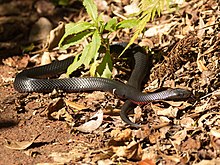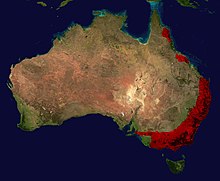| Red-bellied black snake | |
|---|---|

| |
| A red-bellied black snake in Lamington National Park, Queensland | |
| Scientific classification | |
| Domain: | Eukaryota |
| Kingdom: | Animalia |
| Phylum: | Chordata |
| Class: | Reptilia |
| Order: | Squamata |
| Suborder: | Serpentes |
| Family: | Elapidae |
| Genus: | Pseudechis |
| Species: | P. porphyriacus
|
| Binomial name | |
| Pseudechis porphyriacus (Shaw, 1794)
| |

| |
| Range of red-bellied black snake (in red) | |
| Synonyms[2][3] | |
| |
The red-bellied black snake (Pseudechis porphyriacus) is a species of venomous snake in the family Elapidae, indigenous to Australia. Originally described by George Shaw in 1794 as a species new to science, it is one of eastern Australia's most commonly encountered snakes. Averaging around 1.25 m (4 ft 1 in) in length, it has glossy black upperparts, bright red or orange flanks, and a pink or dull red belly. It is not aggressive and generally retreats from human encounters, but can attack if provoked. Although its venom can cause significant illness, no deaths have been recorded from its bite, which is less venomous than other Australian elapid snakes. The venom contains neurotoxins, myotoxins, and coagulants and has haemolytic properties. Victims can also lose their sense of smell.
Common in woodlands, forests, swamplands, along river banks and waterways the red-bellied black snake often ventures into nearby urban areas. It forages in bodies of shallow water, commonly with tangles of water plants and logs, where it hunts its main prey item, frogs, as well as fish, reptiles, and small mammals. The snake is a least-concern species according to the IUCN, but its numbers are thought to be declining due to habitat fragmentation and decline of frog populations.
- ^ Shea, G.; Cogger, H.; Greenlees, M. (2018). "Pseudechis porphyriacus". IUCN Red List of Threatened Species. 2018: e.T42493274A42493282. doi:10.2305/IUCN.UK.2018-1.RLTS.T42493274A42493282.en. Retrieved 9 July 2021.
- ^ Australian Biological Resources Study (26 August 2013). "Species Pseudechis porphyriacus (Shaw, 1794)". Australian Faunal Directory. Canberra, Australian Capital Territory: Department of the Environment, Water, Heritage and the Arts, Australian Government. Archived from the original on 9 July 2021. Retrieved 6 December 2018.
- ^ Species Pseudechis porphyriacus at The Reptile Database . www.reptile-database.org.
